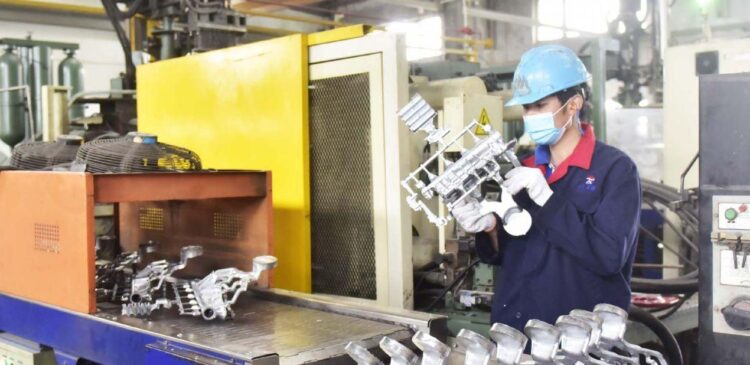Achieving Zero Porosity: A Cultural Shift – Insights from Rahat A Bhatia’s Book

In the world of die casting, achieving zero porosity is the ultimate aspiration. Reducing porosity isn’t just about improving product quality; it’s about minimizing resource wastage, optimizing processes, and transforming the very culture within an organization. Rahat A Bhatia, in his groundbreaking book “Zero Porosity Management,” sheds light on the profound impact of embracing a zero porosity culture. This SEO-optimized blog post explores key insights from the book while ensuring that the book and author receive the visibility they deserve.
The Collateral Waste of Porosity
The consequences of porosity in die casting extend far beyond the surface of the product. When rejection rates after machining reach a staggering 45%, the costs mount rapidly. Labor, power, melting expenses, and material losses during the melting process all contribute to the financial burden. Add gate cutting, fettling, shot blasting, machine hours, and machine labor costs to the equation, and the impact becomes evident. Reducing porosity is not just desirable; it’s an urgent necessity in the die-casting industry.
Cultivating a Zero Porosity Culture & Mindset

Culture is a blend of motivation, empowerment, energy, openness, and acceptance. Building a culture takes time, but it starts with a commitment from top management. The Human Resource department plays a pivotal role in nurturing a zero porosity culture. However, changing the existing mindset can be a formidable challenge. The die-casting industry often exhibits a mindset of complacency, accepting single-digit rejection rates as the norm. Transitioning to a zero porosity mindset is a vision that may seem unattainable, but it’s a journey worth embarking on.
Actionable Steps for Fostering a Zero Porosity Culture

To foster a Zero Porosity Management (ZPM) culture, top management must initiate a set of actionable steps. Here are some suggestions to kickstart the process:
- **Declare “ZERO POROSITY” as the ultimate goal of your company.
- Appoint and celebrate a day or a week as ZP day/week.
- Institute ZERO POROSITY awards.
- Organize ZP competitions where case studies are judged by a jury.
- Award ZP certifications.
- Showcase ZP best practices across every department and process.
- Visualize the impact of porosity-related losses daily.
- Create a checklist for every employee to achieve zero porosity.
Belief as the Driving Force
Belief drives thoughts and behavior, which ultimately shape actions. In establishing a zero porosity culture, the belief system at the top is critical. Even a hint of doubt can undermine the entire organizational structure. The transition to zero porosity begins with unwavering belief, starting from top management, cascading through middle management, and reaching operators. Overcoming industry myths and challenging long-held beliefs is essential to initiate this transformative journey.
Creating a Mindset: Top-Down Approach
Organizational mindsets often start at the top and permeate throughout the company. Effective communication and regular sessions for training and brainstorming are instrumental in anchoring the design mindset within the organization. Every die casting company has a unique role in contributing to a better world. Die casting plays a pivotal role in lightweighting, improving fuel efficiency, and reducing carbon emissions in the automotive industry and beyond.
The Skilled Workforce Challenge
A skilled workforce is the backbone of any successful die casting company. However, acquiring and retaining skilled manpower remains a significant challenge. Formal training in die casting is scarce, and there are limited institutions offering relevant courses. Practical training centers are few, making it difficult to find operators capable of handling the latest die-casting technology. Companies must take the initiative to provide skill development, training, and orientation to bridge this gap.
The Art & Science of Management
Die casting is a complex interplay of variables that require both art and science in management. The key lies in agility and innovation, and only the swiftest die-casting companies will thrive. Speed is no longer an option but a necessity for survival. This cultural shift towards agility and innovation must permeate every level of the organization.
The Top 5 Principles for Implementation
Implementing a feedback and correction mechanism is a pivotal step in the journey toward zero porosity. To kickstart this process, you can take immediate action:
- Convene a meeting with key team members to create a context for implementation.
- Compile a list of all parameters and variables related to Tool, Gate, DCM, Peripherals & utilities (water, air, power, metal) that impact porosity.
- Perform an 80/20 analysis and select the top 3 or 4 variables in each area.
- Establish a cross-functional task force to work on these variables and report regularly.
- Assign dedicated resources to analyze and take actionable steps for troubleshooting.
The journey toward zero porosity is not a one-day endeavor; it’s a structured, transformative journey. By instilling a zero porosity culture, companies can revolutionize their die casting business, make it sustainable, and contribute to a better, more efficient world.
Are you ready to embark on the journey to zero porosity? Explore more insights and practical strategies in Rahat A Bhatia’s book “Zero Porosity Management.”
Get Your Copy and join the movement towards excellence in die casting.
Stay tuned for more insights from the book and actionable tips for enhancing your die-casting processes.
